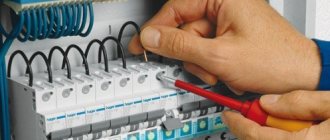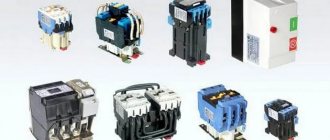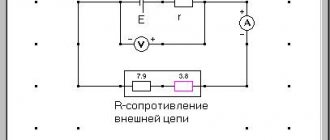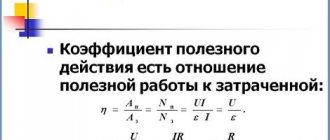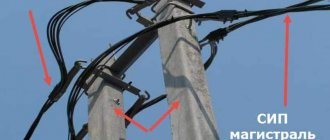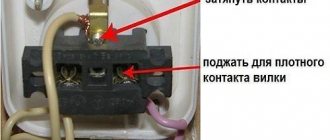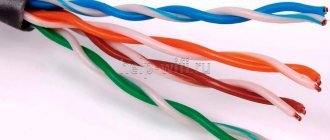For quite some time now, modern homes have stopped using corks. They were replaced by more technological devices - automatic machines, also known as baggers, although some still call them traffic jams, but this is wrong, because the operating principle of a traffic jam and a machine is somewhat different. Since in this article we will consider the selection of a machine depending on the cable cross-section, there will be no talk about traffic jams.
So, the machine is a device that allows you to open the electrical circuit automatically in two cases:
- line current overload;
- occurrence of a short circuit (SC).
In the first case, overload occurs due to a malfunction of electrical appliances or their large number and power density. In the second case, due to a short circuit, electricity is consumed to heat the wires with the maximum possible current for this section. In addition to the above cases of circuit breakage, the machine provides the possibility of manual control. There is a switch on the body of the device that allows you to open the circuit.
The purpose of the circuit breaker is to protect the section of the electrical circuit for which it is installed, as well as timely opening of this section in the event of an overload or short circuit.
Types of slot machines
Classification of circuit breakers occurs according to the following parameters:
- number of poles;
- rated and limit currents;
- the type of electromagnetic release used;
- maximum power switching capacity.
Let's look at it in order.
Number of poles
The number of poles is the number of phases that the machine is capable of protecting. Depending on the number of poles, machines can be:
- Single pole. Protection is provided for one output wire, one phase.
- Bipolar. As a rule, these are two combined single-pole circuit breakers with one common control knob. In a situation where the current of one of the machines exceeds the permitted load, both devices are switched off. Two-pole circuit breakers are used to completely disconnect the load (one phase), turning off the working phase and the working zero.
- Three-pole. They are used with three-phase circuits; if the load is exceeded, three phases are switched off simultaneously. Such machines also have one common circuit breaker.
- Four-pole. Similar to two-pole, but designed to work with three-phase circuits. When the load is exceeded, three phases and the working zero are opened simultaneously.
Rated and limiting currents
Everything is simple here - such a current strength at which the machine will open the circuit. At the rated current and even a little more than stated, work will be carried out, but only when the limit current is exceeded by 10–15% will a shutdown occur. This is due to the fact that quite often the starting currents exceed the maximum possible currents for a short period of time, so the machine has a certain reserve of time, after which the circuit will open.
Type of electromagnetic release
This is a part of the machine that allows you to open the circuit in the event of a short circuit, as well as in the event of an increase in current (overload) by a certain number of times. Releases are divided into several categories, let's look at the most popular:
- B - opening when the rated current is exceeded by 3–5 times;
- C - when exceeded by 5–10 times;
- D - when exceeded by 10–20 times.
Maximum power switching capacity. This is the value of the short circuit current (determined in thousands of amperes) at which the machine will remain operational after the circuit opens due to a short circuit.
Selection of the optimal cable cross-section
Each cable, like a machine, has a certain permitted load current. Depending on the cross-section and material of the cable, the load current also varies. To select a machine according to cable cross-section, use the table.
It should be noted that it is permissible to choose a cable with a small margin, but not a packet switch! The machine must match the planned load! In accordance with the rules for electrical installations 3.1.4, the setting currents of the circuit breakers should be selected that will be less than the calculated currents of the selected zones.
Let's look at an example: in a certain area, the electrical wiring is laid with a cable with a cross-section of 2.5 mm square, and the load is 12 kW, in this case, when installing a machine (at a minimum current) of 50 A, the wiring will ignite, since a wire with this cross-section is designed for an allowed current of 27 A, and much more passes through it. In this case, the circuit does not break, since the machine is adapted to these currents, but the wire is not; the automation will turn off the machine only in the event of a short circuit.
Neglecting this rule can lead to serious consequences!
Important! First, you should calculate the power of the consumers, and then select a conductor of the appropriate cross-section, and only after that select an automatic machine (packet). The rated current of the packet must be less than the maximum current allowed for the wire of this cross-section.
It is thanks to this principle that the wiring will never overheat and, therefore, no fire will occur.
Methods for selecting a difavtomat
Rating of the difavtomat and its time-current characteristics
For example, consider a kitchen where a large amount of equipment is connected. First, you need to set the total power rating for a room with a refrigerator (500 W), microwave (1000 W), kettle (1500 W) and hood (100 W). The total power indicator is 3.1 kW. Based on it, various methods are used to select a 3-phase machine.
Table method
Based on the device table, a single-phase or three-phase device is selected based on the connection power. But the value in the calculations may not coincide with the tabular data. For a 3.1 kW network section, you will need a 16 A model - the closest value is 3.5 kW.
Graphical method
The selection technology is no different from the tabular one - you will need to find a schedule on the Internet. In the figure, the switches with their current load are shown horizontally, and the power consumption in one section of the circuit is shown vertically.
To establish the power of the device, you will need to draw a line horizontally to the point with the rated current. A total network load of 3.1 kW corresponds to a 16 A switch.
Calculation of consumer power
Each electrical network in an apartment or house can be divided into sections (rooms). Depending on what devices are planned to be used in a particular area, electrical wiring calculations are made. Typically, the electrical wiring zones for each machine are divided among themselves into each room of the apartment or house. One section of wiring for one room, the second for another, and the third for the kitchen and bathroom. In this situation, such powerful consumers as electric stoves, ovens, water heaters, and heating boilers stand apart. This technique requires a dedicated power line, so in modern homes designed for use with electric stoves, a separate circuit breaker is installed to provide power to the device.
Calculating the required current for a particular section of wiring is quite simple. To do this, use the formula I=P/U, according to which I is the current strength, P is the power (in watts) of all operating electrical appliances on this line, U is the network voltage (the standard is 220 volts). To calculate, you need to add up the power of those electrical appliances that you plan to use on the line, and then divide the resulting sum by 220. From here we get the current strength, according to which you will need to select a cable of a certain cross-section.
As an example, let’s take an area (room) and calculate for it a machine and a cable of the required cross-section. The following will work simultaneously in the room:
- vacuum cleaner (1300 W);
- electric iron (1000 W);
- air conditioning (1300 W);
- computer (300 W).
Let's add these indicators (1300+1000+1300+300 = 3900 W) and divide them by 220 (3900/220 = 17.72). It turns out that the current strength is 17.72, we select the optimal cable cross-section for this based on the table, take a copper cable with a cross-section of 2.5 mm or 4 mm square (be sure to take it with a reserve) and a circuit breaker with a rated protection current of 20 amperes.
It is worth mentioning that you should not choose a circuit breaker with an overestimated rated current, since if the electrical network is overloaded (exceeding the continuous-permissible current for a particular wire), the wiring will start to catch fire. The rating of the machine must correspond to the value of the continuous-permissible current of the conductor or be less.
Experienced electricians repeatedly say that you should not install cables with a small cross-section because they are cheap; you should choose a cable with a reserve to avoid overloading the electrical section and causing a fire in the wiring. But choosing a powerful machine gun is contraindicated!
The wiring is installed once, it is difficult to replace it, but replacing the switch in the event of a significantly increased load is much easier.
At the moment, more and more powerful electrical appliances are appearing, so it’s worth taking care in advance in case you decide to use a more powerful vacuum cleaner or add some additional device to the room.
What about them?
It just so happens that all new trends come to us “from there.”
In technologically advanced countries, “B” machines have long been installed by default. To put a “C”, you need a calculation justification. Look at the photo that a friend from Germany sent me:
Panel with B16 machine guns in a one-room apartment
Approximately such shields are installed there in budget apartments. Input switching and RCD - on the landing.
And here are the photos I took in Turkey. A store like our Fix Price:
All machines are B16 and B25. Why so - call your local electrician, phone number below)
Photo at the entrance. I have only two questions: what is C32 doing in this row and whose droppings are on the upper terminals? Can flash interphase)))
Please note: circuit breakers with a breaking capacity of 3000 A have long been prohibited not only “with them”, but also with us. But something tells me that Siemens 3000 is better than TDM 4500.
Shield in a hotel in Istanbul:
Left – input C32, right – pulse relay
I didn’t specifically look, I photographed what caught my eye. And in the overwhelming majority I saw the letter “B”.
Nuances
In general, readers should not have any questions regarding the selection of packages according to the cable cross-section, but there are some subtleties that we did not mention above.
- A machine with which type of electromagnetic release to choose. In everyday life, machines of categories “B” and “C” are most often used. This is due to the fastest possible operation of package switches when the rated current is exceeded. This is extremely important when using appliances such as electric kettles, toasters and irons. Depending on the type of equipment used, you should choose a specific category; it is advisable to give preference to category “B” switches.
- A machine with a maximum switching capacity to choose. Depends on the location of the electricity input from the substation to the apartment, if in close proximity, then you should choose one with a switching capacity of 10,000 amperes, otherwise for city apartments there are enough devices for 5,000–6,000 amperes. You can play it safe and choose the option of 10,000 amperes; ultimately, this indicator only affects whether the machine will be operational after a short circuit.
- What type of wire to choose: aluminum or copper We strongly do not recommend purchasing aluminum conductors. Copper wiring is more durable and can handle higher currents.
How inrush currents are reduced
Manufacturers are not fools - they are well aware of the harm and dangers that inrush current brings. Here's what they do to reduce it.
- An NTC thermistor (thermistor) is installed at the power input of electronic devices, which, due to its physical properties, has a high resistance in a cold state. Of course, this is not a panacea, and there are restrictions on their use associated with a decrease in the efficiency of the device as a whole.
- Inverter power supply for soft start. By this I mean powering the motors through semiconductor starters. Frequency converters, soft starters and the proud inscription “Invertor” are from this opera.
- Delayed power supply via relay. In this case, part of the power is supplied first, and after a split second - 100%. I wrote about this above and gave the example of the MRP relay. This is how frequency converters and other powerful electronic devices are turned on.
- Motor power supply via Star-Delta circuit. These are not found in everyday life, since there are no powerful three-phase motors, but for the sake of completeness I have included them.
- An increase in cos ϕ and a decrease in harmonics and the reactive component of the supply current also contribute to the overall cause.
Fortunately, inrush currents, unlike rated currents, in most cases do not act simultaneously. If you turn on the power in an apartment, it is better not to do it through the main (input) switch. The rule of good manners is to supply power sequentially after turning on the input machine, turning on the group machines one after the other.
What is it needed for
The machine is considered a device whose main task is to ensure safe use of the electrical network. He also deals with protecting equipment from overcurrent, which is considered an overload short circuit. Such equipment is turned on and off from an electrical circuit. It is equipped with either an electromagnetic release or a combined type. Thanks to this, the circuit can be protected. Its main advantage is the fact that it allows you to protect an electrical installation or transformer substation from short circuits, network overloads and breakdowns as a result of frequent network outages.
Network protection as the main task of a circuit breaker
It has on its body markings of the rated current, switching capacity, current limiting class, rated breaking capacity and time-current response characteristics of the release system. It can be single-pole, two-pole, three-pole and four-pole and is suitable for the network phases corresponding to the name.
Important! Most often it is used to protect an electric stove or other kitchen heating appliances. It is also used to protect the lighting system with motor and transformer systems.
Principle of operation
The main element of the device is an electromagnetic one with a thermal release. The first guarantees protection against short circuits, the second - against overvoltage. An electromagnetic device is a coil with a core, which is placed on a special spring and, under normal conditions, creates an electromagnetic field that attracts the coil core. At the moment of a short circuit, the electric current increases and exceeds that nominally stated according to the technical characteristics. This current flows through the release coil and increases the field. As a result, the circuit is de-energized.
The heating unit comes into operation when an overload occurs. This is a bimetallic strip with metal A and B.
Important! At the moment of overvoltage, current flows to the plate, it heats up and, due to the property of B to expand, the surface bends and the movable type of contact opens.
You might be interested in DIF or RCD
The principle of operation of any circuit breaker
